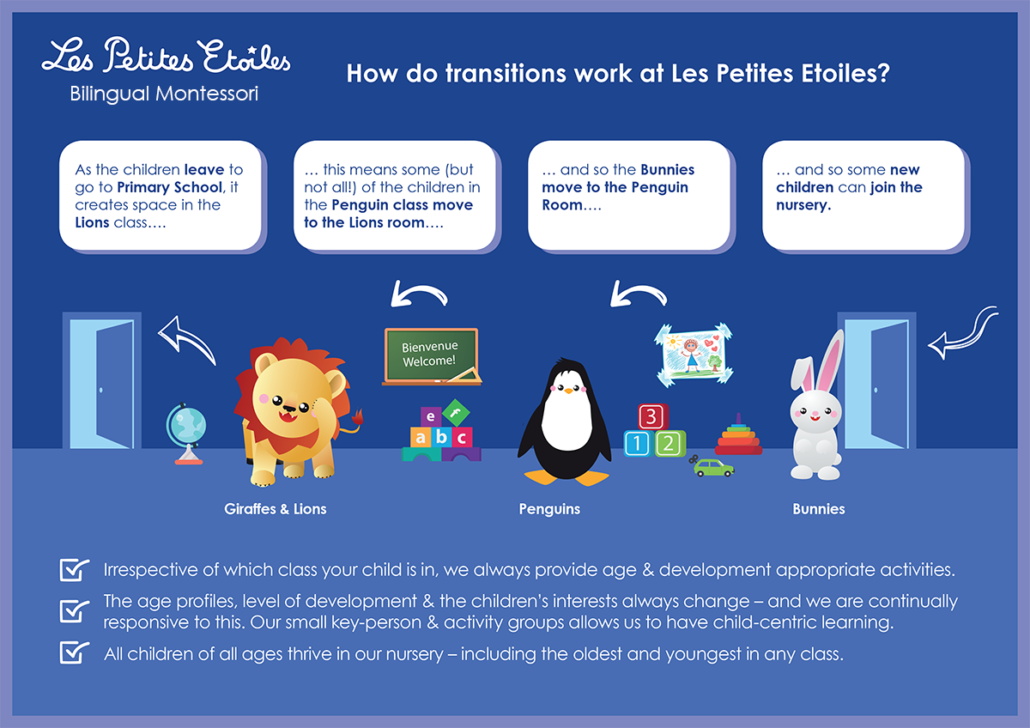Tailoring Teaching to Your Child’s Needs
The right activity
Each classroom has several staff members, which allows several activities to occur at the same time in each of the rooms. We carefully consider the children to provide the appropriate range of stimulating activities for them.
The same or similar activities can be pitched at quite different levels by the key people. For instance, a very young child might simply enjoy looking at the pictures in a book, whereas an older child might be doing phonics work when s/he looks at books. Similarly, construction blocks can be a question of practicing gross motor skills, or could involve arranging, sorting and more sophisticated balancing. The key for us is to ensure we know the children well so we can pitch the right
activities in the right way for each of the children according to their abilities.
Their own pace
We encourage and give space to allow the children to develop at their own pace. Children learn to walk, or potty train at their own pace and not necessarily in sync with their other learning and development.
This is perfectly normal, and we will rearrange the room, the routine and the way we encourage each child to ensure s/he feel motivated during this process.
Each child’s interest
Each child’s interest is also of vital importance. We use the following example to explain what we mean by this: we had a little boy who had no interest in counting or any maths activities. However, he was very interested in vacuum cleaners. So his key person obtained a few pages filled with vacuum cleaners from a catalogue. The boy enjoyed the fine motor skill exercise of cutting out these Hoovers. He then enjoyed sticking them onto colourful cards. At this point, the key person took three cards and left all the others for the boy. She slowly started counting hers. She had three. With no further prompting the
boy wanted to count his. By engaging his interests, counting was suddenly relevant to him.
Supporting children to thrive
Our philosophy is that by engaging a child’s interests, we will support (or “scaffold”) their learning. This combination of knowing the children, taking their level of development and their interests into consideration, allows us to support children to thrive. This approach is used in all the classrooms, and is the most influential factor of how we care for the children and teach them.
The divisions of the classrooms
The exact division of the classrooms is determined simply by putting the oldest group of the children in the Lions room, the middle group in the Penguins room, and the youngest group in the Bunnies. Usually our rooms are full all year round, so a child will usually stay in the room all year.
Some years we have little movement (for example, if the previous year was very young overall, then few if any of them will leave for Primary school at the end of the year). In these cases, children will probably stay in the same group for more than 1 year.
Room transition

Mixed age groups
Some years we have mixed age groups in a room depending on the overall age of the children at the nursery. We think this can be beneficial for the children. Older children can learn a lot by being with younger children. They can take stock of their own learning, and spontaneously help younger children. This helps them develop leadership, encourages responsibility as well as creative and interpersonal skills. This can help them better understand their own mental processes.
Younger children can also benefit, as they look up to their “elders”. Children find it easy to learn from their peers as well
as from adults, and a mixed age environment is very beneficial to aid this type of learning.
In all these different cases, the children do well in our care because of our focus on each child’s individual interests and abilities as detailed above. This is the most important factor – irrespective of the classroom, each child will always have age appropriate activities presented to him/her.






